By Museum Volunteer Andy Ludlum
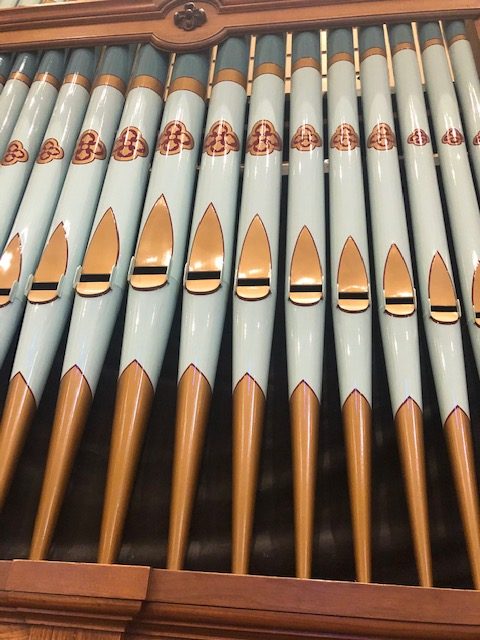
Two pipe organs – each more than 150 years old – have traveled to Ventura County from the east coast, survived earthquakes and fires and are now believed to be among the oldest pipe organs in California. One organ hasn’t been heard for 26 years but is being transformed for a new life and preserved for possible restoration in the future. The other is temporarily silenced while being cleaned after smoke damage sustained in a massive California wildfire.
Wildfire Bears Down on Oak Park Church
It was nearing 11 p.m. on November 8, 2018. The Woolsey fire had burned into Oak Park. Law enforcement was stretched thin, dealing with evacuations in Simi Valley, Camarillo Springs, and Newbury Park as well as Oak Park. The fire moved faster than anyone expected, resulting in a delay in issuing mandatory evacuation orders for 4,000 homes in Oak Park. In a one-hour traffic jam, evacuees snaked their way down Kanan Road to the relative safety of the 101 freeway. As they passed the corner of Kanan and Churchwood Drive, they could see the hillside above the Episcopal church had erupted in flames.
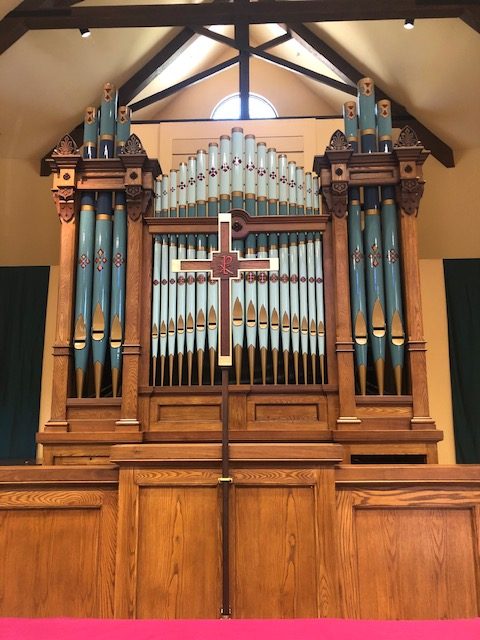
Thanks to the determined efforts of the Ventura County Fire Department, the church buildings were spared from the scorching heat so intense that it burned the mulch in the planters around the church and throughout the parking lot. But a great deal of smoke and soot got into the church and settled inside the 1869 E. & G. G. Hook pipe organ, believed to be the oldest unaltered organ of its kind in California.
Shortly after the fire, the Music Director and organist at Epiphany, Jay Wilcox, noticed some changes in the sound of some of the pipes. Regular variations in temperature and humidity can shift some of the sensitive pipes in an organ slightly out of tune. It took the trained ear of someone intimately familiar with the organ to notice something was wrong. After experts determined that continuing to use the organ would not make the damage worse, the church began working with its insurance company to clean and repair the organ.
The 151-year-old organ had an interesting past before finding a home in the Oak Park church in 1999. It was the 505th organ made by E. & G. G. Hook, pioneer organ builders from 1827-1880. The Hook brothers, Elias and George G. were the sons of a Salem, Massachusetts cabinetmaker. After apprenticing under a famous Boston organ builder, the brothers returned to their hometown and set up shop. By 1849 they had built 100 custom organs of increasing complexity. By 1854 they had built their first 4-manual (keyboard) organ and had moved into a large, steam-powered factory in Boston. In the years after the Civil War, the Hook brothers were making 30 or more organs per year.
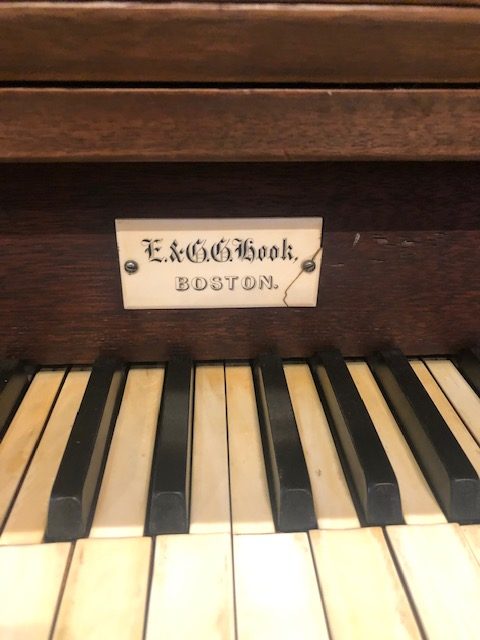
Their productivity was due in part to a shift away from custom organ building. E. & G. G. Hook was the first company to offer stock models that could be ordered from a catalog and built quickly. Epiphany’s organ was one of these stock models and was originally built for the Greene Street United Methodist Church in Philadelphia. In 1996, organ collector Robert Whiting purchased the organ from the church, which had closed. He commissioned an extensive renovation of the instrument but passed away before the organ could be finished and installed in his studio. Whiting’s estate completed negotiations with the Episcopal Church of the Epiphany in 1999 for the $90,000 purchase of the organ, including the remaining restoration and installation.
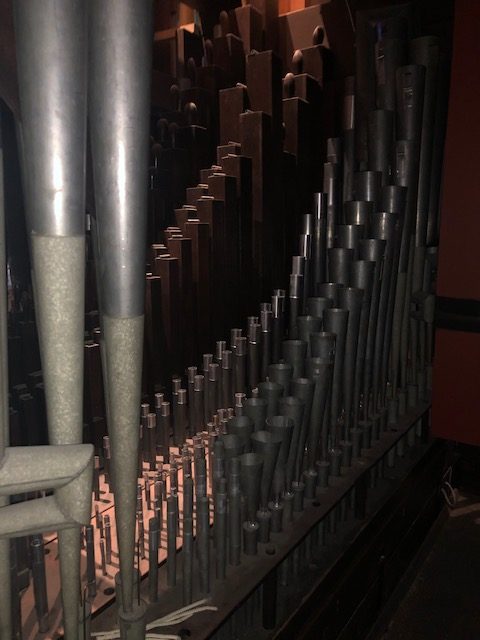
A year and a half after the Woolsey fire, the insurance company gave Epiphany the go-ahead to fully clean the entire instrument, covering the total cost of just under $20,000. This will involve removing all the pipes, hand washing them with a chemical solution, then rinsing and carefully drying them. This is particularly painstaking with the delicate reed pipes.
The organ’s large painted façade pipes will not be removed and will be cleaned in place. Fire dust and soot will also be removed from the entire interior of the organ and the wind chests. Due to the age of the organ, mechanical repairs will be made if problems are discovered during the cleaning. The cleaning and restoration work is being done by Rosales Organ Builders, Inc., who worked on the organ in the Walt Disney Concert Hall in Los Angeles. The cleaning started in February 2020 and was expected to take about three months but may take longer due to the church’s closure during the coronavirus outbreak. It is believed that this instrument is now the oldest unaltered 2-manual pipe organ in California.
Piru Organ Still Standing After Two Earthquakes 88 Years Apart
A pipe organ in Piru is a few years older than the Epiphany organ. Its colorful history includes sailing halfway around the world and surviving the great 1906 San Francisco earthquake only to be damaged 88 years later by the Northridge earthquake.
No nameplate or signature has been found on the organ, but based upon examination of its console construction, casework and pipe measurements, experts have concluded the organ was built in 1864-1865 by William A. Johnson of Westfield, Massachusetts.
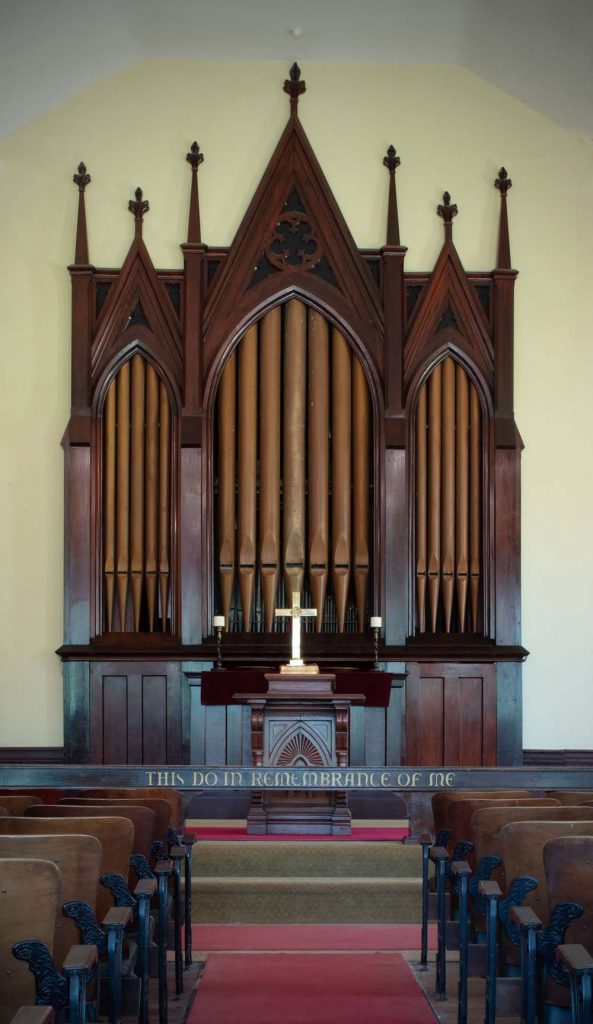
The organ was originally built for a Massachusetts church. Sometime around 1900, it was transported 17,000 miles by ship around Cape Horn to a church in San Francisco. The organ survived the 1906 earthquake and fire that destroyed much of the city. According to the Organ Historical Society Pipe Organ Database, it went to the Eastside Presbyterian Church in Stockton where the parts damaged in the quake were likely replaced. The words “Stockton, California” are inscribed on one of the organ’s wooden pipes. After many years of service, the organ was retired and put in storage.
In 1933 Piru resident Hugh Waring purchased the organ for $280, the price of storage. When it was installed at the Piru United Methodist Church in 1935 it had 15 ranks of pipes, with 748 pipes ranging in size from pencil-length to 16 feet. Each of the organ’s two manuals have 56 keys. The organ uses a centuries-old design of levers and pulleys to connect the wind chest and keys with the various pipes. The original, solid walnut freestanding case for the organ did not survive and the instrument is housed within the walls of the church.
The church was built as an Episcopal church in 1890 by Piru founder and builder David Caleb Cook. Cook saw the church as the centerpiece of his vision to create the town as a “second Garden of Eden.” (Near the church Cook planted a garden with only fruits specified in the Bible, such as apricots, dates, grapes, figs, olives and pomegranates.) The church and the organ were designated as Ventura County Historical Landmarks in 1979.
In the early 1960s, two ranks of pipes from the Piru organ were taken to be repaired. Hearing nothing after a year, the pastor went on a search for the repair company and the missing pipes. He ran into dead ends in Los Angeles and Sacramento, but finally tracked the pipes to San Francisco. Visiting the city for a conference, he called the repair company and was told the pipes were “under other things” and couldn’t be retrieved. The pastor said he would be on their doorstep at eight the next morning and if the pipes weren’t available, he’d return with the law. The next morning, the two ranks of pipes were nicely packed and ready to go. In 1976, the organ was renovated for $3,500. A few years later it was proclaimed to be oldest operating organ in California. That designation ended in 1994 when the organ was silenced by damage sustained during the Northridge earthquake.
The church was also struggling. By 2011, the Methodist congregation in the largely Catholic town numbered in the twenties. The minister was only part-time. Set rental income from movie and TV companies supported the church. (It appeared in several productions from standing in as an Appalachian town hall to serving as the backdrop for an episode of Desperate Housewives.)
The few remaining congregants were absorbed by other churches and the struggle finally ended. In mid-2019 the church and its organ were purchased by Los Angeles artists Lisa Crockatt and Cliff Nielsen. Crockatt said she and her husband have a love of historic architecture. They have worked with the Ventura County Planning Commission in converting the old church into a home and studio. “When we found out about the church being available for purchase, it wasn’t hard to imagine it being our home and art studio. It is of our greatest interest to preserve the pipe organ and church structure while being good stewards until sometime that both pass on to the next guardian.” They intend to preserve the pipe organ in its current state and hope one day to restore it to playable condition.
How Does a Pipe Organ Work?
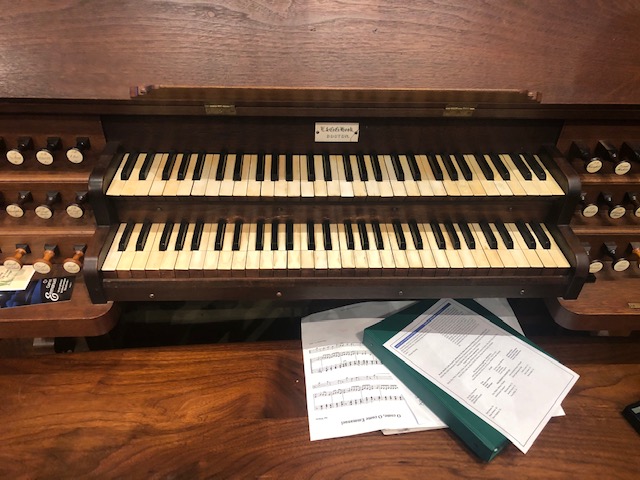
A pipe organ makes sound by pushing pressurized air through pipes selected from a keyboard, or manual. The term “manual” is used for any hand keyboard to distinguish it from the pedalboard, which is a keyboard that the organist plays with his or her feet.
The pipes are in sets called ranks. Most organs have many ranks of pipes of differing timbre, pitch and volume. Each pipe produces a single pitch, so multiple pipes are necessary to accommodate the musical scale. The longer the pipe, the lower its pitch. When a key is pressed, air is allowed into the pipe. The organist selects which ranks of pipes will make sound by using controls called stops.
Organ pipes are divided into flue pipes and reed pipes according to their design and timbre. About eighty percent of the pipes in a typical pipe organ are flue pipes. A flue pipe consists of a hollow cylinder with an opening in the side of the pipe, sounding like a recorder. The rest of the pipes are reed pipes. A reed pipe consists of a hollow cylinder containing a vibrating strip of metal connected to a hollow cone. The vibrating strip or reed produces a sound like a clarinet or saxophone.
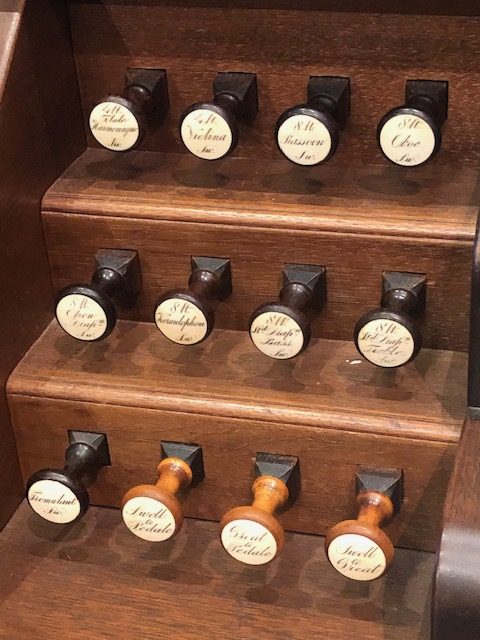
History of Pipe Organs
“To my eyes and ears the organ will ever be the King of Instruments.”
Wolfgang Amadeus Mozart
The organ is one of the oldest instruments. The first documented organ was built in 3 B.C. by a Greek named Ktesibios. Organs didn’t become common in churches until the 13th century. Besides churches, pipe organs have been installed in concert halls, schools and public buildings. In the early 20th century pipe organs were put in movie theaters to accompany silent films.
Pipe organ technology has changed very little over the centuries, except for the addition of motors to blow air through the pipes.
The largest pipe organs are by far the biggest and most complicated musical instruments ever built. According to Sir George Grove in his Dictionary of Music and Musicians, 1889, “The organ is, together with the clock, the most complex of all mechanical instruments developed before the Industrial Revolution.
Other Noteworthy Organs in Ventura County
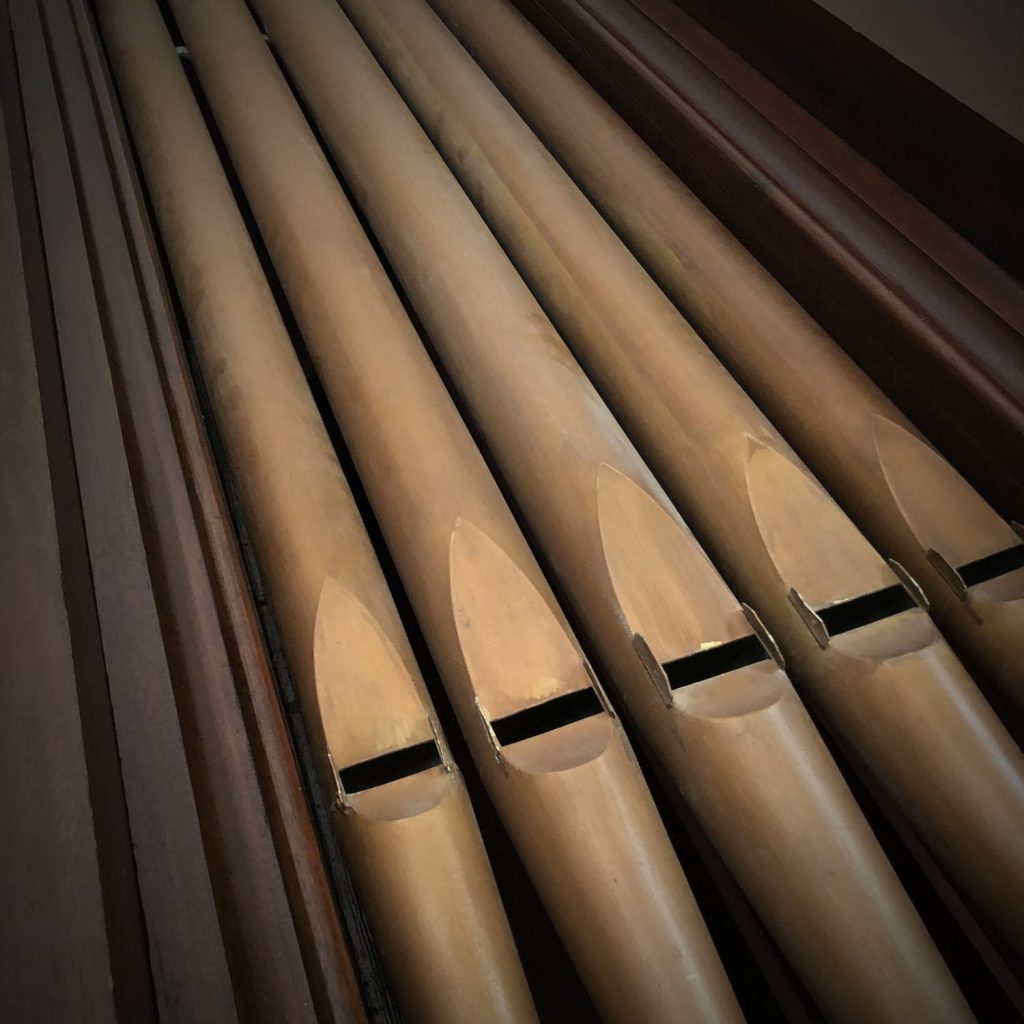
Having an organ, even a modest one, was important to a growing pioneer community. There are numerous newspaper accounts of efforts to raise funds for school and church organs in Ventura County dating back to 1876.
One account in the Ventura Free Press in 1895 describes the Methodist church services being held in George Faulkner’s apricot pitting shed on his 150-acre farm in Santa Paula. Faulkner’s pump organ was moved into the shed to provide music for the services which included a choir, Sunday School and even a collection from the 70-member congregation. A sermon was preached from behind a pulpit of fruit trays. The apricot pitting shed services became famous over the years.
The county’s first pipe organ was dedicated in April 1905 before a “vast throng of people” at the Oak Street Methodist Episcopal Church in Ventura. The Free Press said the big organ was freighted from New York several months earlier and described it as a “magnificent instrument of perfect tone and excellent construction and one that would do credit to a church and a city of far greater pretentions.”
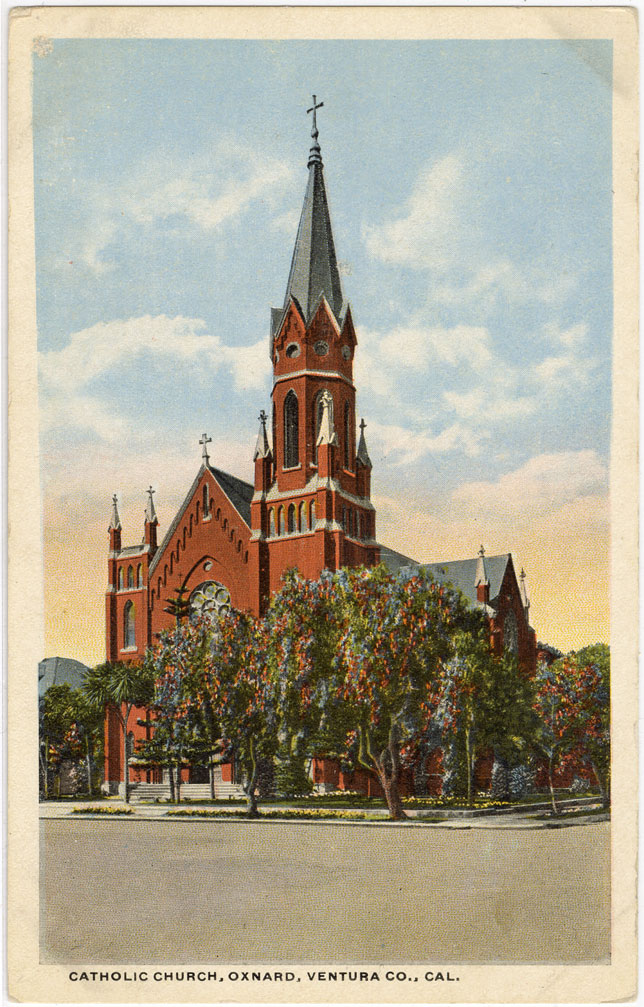
In 1916, Santa Clara Valley pioneer John Borchard made a $5,000 gift to the Santa Clara Catholic Church in Oxnard. With his donation, the church was able to replace its small reed organ with an Austin pipe organ considered “one of the finest on the Pacific Coast.” It was played in the church until it was retired in 1985. Borchard’s granddaughter, Cecelia Friedrich Voelker, in a 1985 oral history preserved in the Museum’s Research Library, recalled playing the organ for 30 years. “When I was in school, in the 8th grade, Sister said, ‘Well your grandfather gave the organ, so I think you should learn how to play it.’ So, from the 8th grade on I played for the children.” The Austin organ was replaced by a Schoenstein organ in 1985. It is regularly played at Mass today.
In 2001, a father and son team, Frank and Shaun Kiernan, refurbished an aging 1928 Austin pipe organ at Mission San Buenaventura. The mission organ cost $6,800 when purchased and after it was refurbished it was worth $160,000.
In 2003, the congregation of the Universalist Unitarian Church of Santa Paula brought to life a 1924 Estey pipe organ that hadn’t been played for 20 years. The old organ was worn out and in 1984 the church started an effort to raise the $32,000 needed for the restoration. By 2000, the congregation had raised half the money. A member family donated the balance. The restoration was completed in the spring of 2003 and the organ was rededicated two days short of its 80th anniversary. The Reverend Maddie Sifantus says even though the huge Thomas fire of 2017 raged through the area near the church, smoke damage was minimal and didn’t affect the organ.
The county’s largest pipe organ was completed in Thousand Oaks in 2009. The Reuter/Salmen pipe organ at Ascension Lutheran Church has 49 ranks of pipes and three manuals.
Organs in the Museum of Ventura County Collection
The Museum of Ventura County has two organs in its collection.
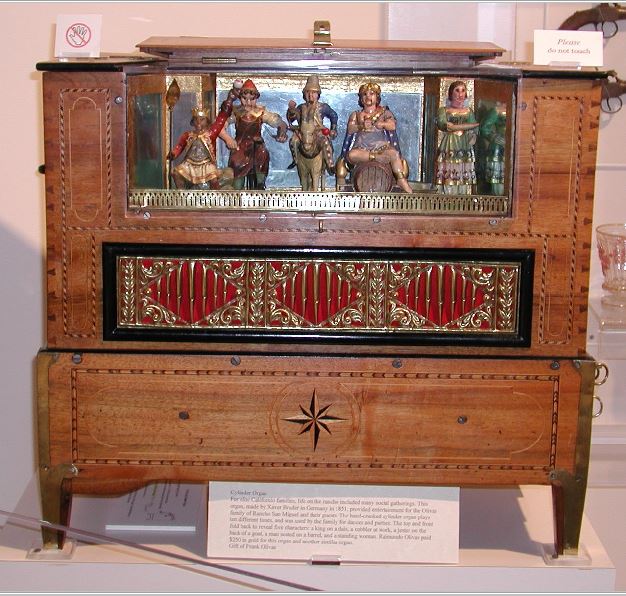
This cylinder organ is made of polished wood with several lines of decorative inlay on the front panel sections. Rather than being played by an organist, a cylinder organ works when a person turns a crank playing music encoded on wooden barrels or cylinders. This organ stands on four feet which are reinforced with a decorative metal for one third of the height of the organ. Half of the top and a section of the front open and fold back to reveal a small stage on which are seated five characters in a merry-making scene: a king seated on a dais, a cobbler at work, a jester on the back of a goat holding what appears to be a scepter, a man seated on a bunged barrel with a goblet in his hand and a woman standing with a plate in her hand. The background of the scene is a series of framed mirrors. The top folds down to conceal the stage and can be locked. On the back is the crank for operating the machine. The markings inside the organ (Xaver Bruder July 8, 1851 im Waldkirch) indicate it was made in Germany. It was reportedly sold to Raimundo Olivas for $250 in gold.
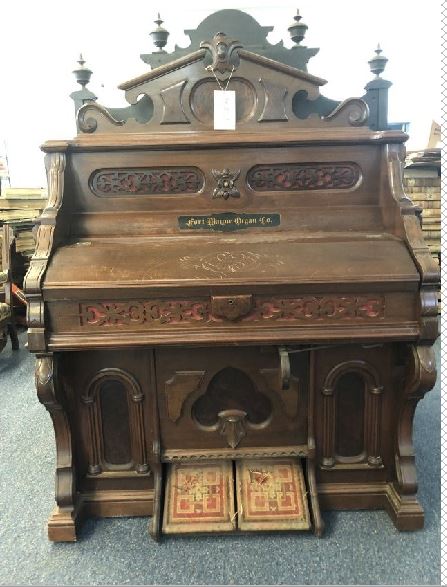
This mahogany-cased pump organ, utilizing pneumatic valving, creates sound using reeds like those in an accordion. The case is topped by a pediment, with three insets of birdseye maple below it. The keyboard has five octaves and above the keyboard are nine voice knobs. The two pedals are covered with a heavy colored rug material. This type of organ was widely found in smaller churches and private homes. Markings on the organ give some clues as to its origin – “Fort Wayne Organ Co.” is on the face of the organ and “Packard Orchestral” is on the inside of the lid.
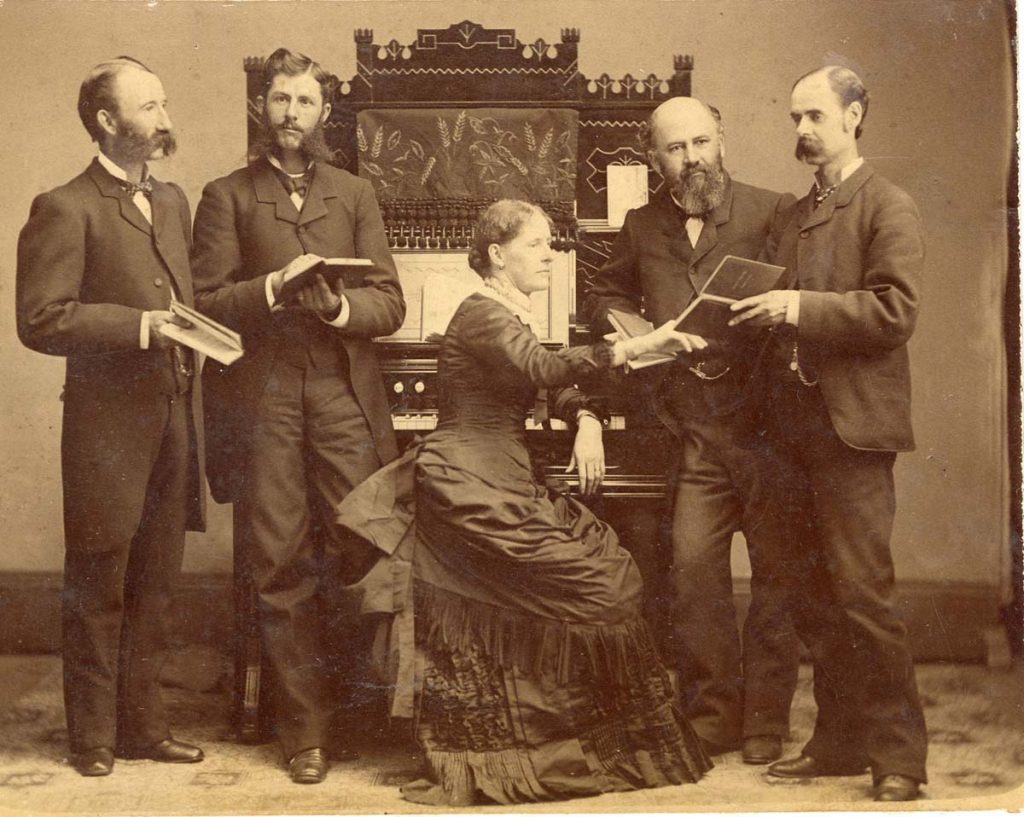
Make History!
Support The Museum of Ventura County!
Membership
Join the Museum and you, your family, and guests will enjoy all the special benefits that make being a member of the Museum of Ventura County so worthwhile.
Support
Your donation will help support our online initiatives, keep exhibitions open and evolving, protect collections, and support education programs.
Bibliography
- “Barrel Organ.” Wikipedia, the Free Encyclopedia. Last modified September 26, 2004. https://en.wikipedia.org/wiki/Barrel_organ.
- Carlson, Cheri. “Ventura County authorities call for changes after review of two fast-moving fires.” Ventura County Star, January 18, 2020.
- “E. & G. G. Hook – Opus 505, 1869.” The OHS Pipe Organ Database. Accessed April 14, 2020. https://pipeorgandatabase.org/OrganDetails.php?OrganID=9398.
- “E. and G.G. Hook & Hastings.” Wikipedia, the Free Encyclopedia. Last modified February 7, 2006. https://en.wikipedia.org/wiki/E._and_G.G._Hook_%26_Hastings.
- Johnson, Brett. “Tiny Piru Church has big history and movie-star looks.” Ventura County Star, December 24, 2011. http://archive.vcstar.com/lifestyle/tiny-piru-church-has-big-history-and-movie-star-looks-ep-364075091-352199101.html/.
- Martelle, Scott. “Father and Son Pull Out All the Stops.” Los Angeles Times, May 4, 2001.
- Maulhardt, Jeffrey W. The First Farmers of the Oxnard Plain. A Biographical History of the Borchard and Maulhardt Families. Ventura: MOBOOKS, 1999.
- Ott, Edith. “Dedication Recital for the Largest Pipe Organ in Ventura County Nov. 22nd.” Ventura County Star, November 12, 2009.
- Oxnard Courier. “Triple Celebration Marks Feast of Patron Saint of Santa Clara Church.” August 17, 1917.
- “Pipe Organ.” Wikipedia, the Free Encyclopedia. Last modified November 22, 2002. https://en.wikipedia.org/wiki/Pipe_organ.
- Ryan, Nolan. “Detroit firm breathes new life into pipe organs.” The Detroit News, July 20, 2018. https://www.detroitnews.com/story/news/local/detroit-city/2018/07/21/detroit-firm-breathes-new-life-into-pipe-organs/775739002/.
- Santa Paula Times. “Rededication of recently renovated 1924 Estey pipe organ Sunda.” October 8, 2004.
- “Schoenstein & Co. Opus 98 (1985).” OHS Pipe Organ Database. Accessed April 14, 2020. https://pipeorgandatabase.org/OrganDetails.php?OrganID=36369.
- Ventura Free Press. “Pipe Organ Dedicated.” April 14, 1905.
- Voelker, Cecelia F. “Oral History Cecelia Friedrich Voelker.” By Museum of Ventura County. Cassette tape. 1985.
- “Wm. A. Johnson – Opus 161, 1864, This installation by unknown builder Opus 161 (1934).” The OHS Pipe Organ Database. Accessed April 14, 2020. https://pipeorgandatabase.org/OrganDetails.php?OrganID=5418.
- “Wm. A. Johnson Opus 161 (1864).” The OHS Pipe Organ Database. Accessed April 14, 2020. https://pipeorgandatabase.org/OrganDetails.php?OrganID=59686.

